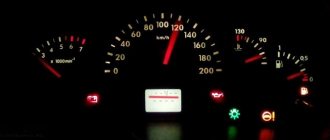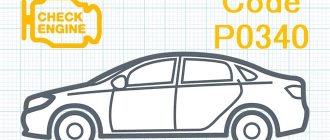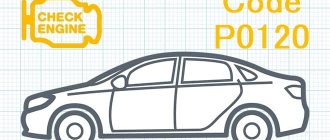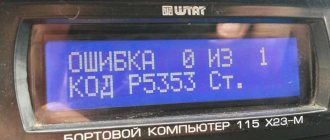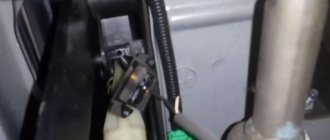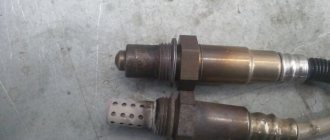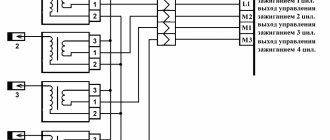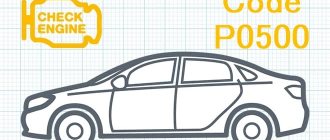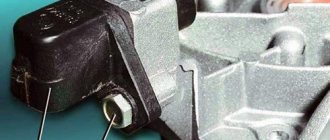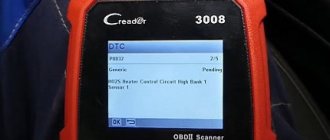Technical description and interpretation of error P0830
OBD II Trouble Code P0830 is a generic code that is defined as “Clutch Pedal Position Switch “A” Circuit Malfunction.” Set when the powertrain control module (PCM) detects a general malfunction.
It is also possible that the clutch pedal, the position switch itself, or the electrical circuit that is directly connected to the clutch pedal position switch may have failed. It is important to consult your vehicle's manual to determine which part of the clutch pedal position switch is labeled "A".
The purpose of the clutch pedal position switch is to control the position of the clutch pedal as a safety measure. To prevent the engine from starting when the manual transmission is not in neutral.
In practice, the clutch pedal position switch is a simple open switch (ON-OFF). Which is installed in such a way that the clutch pedal acts directly on it when pressed.
In a fully functional system, this simple switch makes it impossible to start the engine unless the clutch pedal is fully depressed. However, note that a malfunctioning or failing switch will set the P0830 code, but the warning light may not illuminate.
The clutch pedal switch "A" circuit is designed to allow the PCM to control the position of the clutch pedal. This process is performed by reading the output voltage of the clutch position sensor.
Self-diagnosis
In a car, the operation of the entire electronics system is monitored by a control unit (ECU). In order for the driver to recognize operational failures in time and localize them, cars leave the assembly line with an already built-in diagnostic system. It is located on the front panel. With its help, the system itself detects failures in electronic devices and notifies about them, generating errors with digital codes or their combinations. In this way, the car self-diagnosis occurs. To be able to decipher error codes, special tables have been compiled. In this case, self-diagnosis is carried out on the instrument panel, and not on the computer.
To check, you need to reset the daily mileage data on the wheel revolution meter (odometer), then activate the ignition (position 1).
On all touch devices, the arrows will move twice to the highest readings.
By pressing the odometer button again, messages are received about the installed version of the operating system. The next time you press the button, an indication of problems, if any, is displayed.
What errors may appear during self-diagnosis of the control panel, and how to decipher them
0 - indicates that there are no problems in the electrical wiring, apparently the fault is mechanical;
1 - indicates a malfunction of the ignition system microprocessor;
2 - no signal is detected coming from the circuit leading to the fuel level sensor. Reason: open circuit, plaque formation due to oxidation of contacts or short circuit;
4—signal of increased voltage in the on-board network (more than 16 V). It is necessary to check the battery and generator;
8—opposite signal, the voltage is too low (less than 8 V) due to a low battery or problems with the generator.
If there is not one malfunction, but a group, then an error is displayed on the dashboard, the code of which consists of several digits resulting from the summation of errors. So, for example, the issued error code 10 indicates errors 2 and 8, 6 – the sum of 2 and 4, 12 – 4 and 8, 14 – 2,4 and 8.
12 - a malfunction in the circuit leading to the malfunction indicator lamp, possibly due to damage to the connector contacts or their oxidation, or the indicator itself is faulty;
13 - no data is received from the oxygen concentration sensor device (ƛ-probe). The sensor or the wiring leading to it may be faulty;
14—the coolant temperature in the cooling system is higher than normal. Reasons: sensor failure, low fluid level in the radiator, faulty thermostat;
15 - coolant temperature is below normal. Reasons: a failed thermostat, air entering the system due to a coolant leak;
16 - the voltage in the on-board network is too high;
17 - the voltage in the on-board network is too low;
19 - malfunction in the wiring of the PCV sensor. Reasons: oxidation or contamination of contacts, broken wiring, short circuit, mechanical failure of the wheel;
21-22 - error in the position of the remote sensing sensor, due to a failure of the electronic part, due to a breakdown of the movable core or due to the fact that the coating on the slider has been worn off;
23-25 - deviation from the norm of the intake air temperature sensor. Possible reasons: clogged sensor element, oxidation of contacts, open circuit, short circuit;
24 - the speedometer does not provide reliable data on the vehicle speed. Reasons: the speedometer has mechanical damage, there is contact in the terminal connections, the sensor is faulty, there is a break or a short circuit in the wiring, the computer is malfunctioning;
27-28 - warning about a violation of the level of exhaust gases for one of the reasons: damage to the wiring, the catalytic converter has become unusable, the muffler and muffler suspension are damaged;
33-34 - error code for mass air flow data. Causes: high voltage in the wiring going to the sensor device, interference affecting the impulse from close proximity of wires or sensor to devices with high voltage (generator, ignition wires, etc.), wear of vacuum and air intake hoses;
35 - malfunctions occur when the engine is idling; they can occur due to a malfunction of the hydraulic compensators in the valve mechanism drive, a malfunction of the TPS, or due to unaccounted for air leaks;
41 - pulse error from the camshaft sensor rarely occurs. Cause: damage to the wiring or malfunction of the sensor itself;
42 - malfunction of the ignition system. Reasons: breakdown of the ignition coil or high-voltage electrical wiring, and possibly incorrect spark plug gap setting;
43 - lack of signal from the detonation sensor device. Reasons: sensor failure, contact oxidation or wiring fault;
44-45 - the stoichiometric combustible mixture is incorrectly formed. Causes: incorrect air/fuel ratio, faulty throttle sensor or oxygen sensor;
49 - the on-board computer registers a loss of vacuum for one of the reasons: loss of tightness of the pipeline or working chambers of the amplifier, failure of the check valve;
51 - an error in the operation of the ROM requires checking the connector, injector harness and all wiring, as well as the ground of the control unit;
52 - there is a problem with the operation of the random access memory, it is necessary to diagnose the microprocessor;
53 - there is no signal from the exhaust gas controller;
54 - the octane corrector controller does not respond, it is either de-energized or faulty;
55 - high engine load. Reasons: damage to the power circuit, violation of the cooling mode of the unit, load on the shaft due to worn bearings, sudden changes in voltage in the wiring;
61 - distorted oxygen sensor data. Causes: sensor malfunction, unreliable connection of the contacts of the controller, sensor and ignition system harness or damage to the harness;
Self-diagnosis does not always accurately display breakdowns. The error code can only indicate the section of the electrical wiring where the malfunction occurred. There may also be software glitches that may cause errors to not always be displayed correctly. To obtain more accurate diagnostic data, you should use external devices (diagnostic scanners, computer diagnostics).
Symptoms of malfunction
The main driver symptom of P0830 is the MIL (Malfunction Indicator Light). It is also called Check engine or simply “check light”.
They can also appear as:
- The “Check engine” warning light on the control panel will light up (the code will be stored in memory as a malfunction).
- The engine will not start.
- The engine will start without engaging the clutch.
The severity of the P0830 code is usually moderate, but it can be serious if the vehicle is started with the clutch disengaged, creating a safety hazard.
Reasons for the error
A P0830 code may mean that one or more of the following problems have occurred:
- The clutch position sensor switch is faulty.
- Incorrectly adjusted clutch pedal position switch.
- The fuse or fuse link has blown.
- Corroded or damaged connector.
- Faulty or damaged wiring.
- Poor electrical connection in the circuit.
- Sometimes the cause is a faulty PCM.
How to Troubleshoot or Reset Trouble Code P0830
Some suggested steps to troubleshoot and fix the P0830 error code:
- Inspect the wiring for damage, fraying, breaks, or short circuits. If the wiring is damaged, repair or replace it.
- Clear any diagnostic trouble codes from the PCM and test drive it to see if the P0830 diagnostic trouble code returns.
- Check the clutch position sensor switch.
- Adjust the clutch pedal position switch if necessary.
- Check the fuse or fuse link.
- If everything is OK, the PCM may need to be replaced and reprogrammed.
Diagnostics using the dashboard
It is advisable for the owner of the Russian model we are considering to remember all the error codes that may periodically occur in the system. In addition, it is recommended that you learn how to diagnose the dashboard yourself. It is designed to reflect error codes that occur in the electronic components of the Lada Kalina.
To start the diagnostic process, you will need to press a button that records the daily mileage. While holding it, turn on the ignition by turning the appropriate key. If this manipulation is performed correctly, the arrows on the scales of the speedometer, tachometer and auxiliary indicators will begin to move along a circular path, moving from the initial to the final position.
Upon completion of this movement of the arrows, the owner will need to switch the screen to another mode. This will be done by a special button located on the wiper switch under the steering wheel. Pressing displays a picture with performance indicators of a wide range of devices controlled by the ECU. The software version of the complex is also displayed here - self-diagnosis.
After updating the information three times, the error codes themselves appear on the device, expressed in digital form.
Let's look at the list of errors by number:
The “E” symbol deserves special attention, which indicates the presence of errors contained in the “EEPROM”. Each malfunction, including error 4 and error 8, requires attention from the car owner.
Diagnosis and problem solving
To eliminate all options for the occurrence of error P0830, you should visually inspect the wiring going to the input and output speed sensors. Check all system fuses and replace blown ones if necessary. Also check the battery under load, cable connections and generator power.
Find the diagnostic connector, connect the scanner and get all the stored codes and data. Write down this information as it may help you with further diagnosis. Clear the codes and test drive the vehicle to see if the P0830 code appears again after resetting.
Voltage check
Locate the clutch position sensor switch and inspect for obvious physical damage. Perform a thorough visual inspection for obvious defects such as scratches, abrasions, exposed wires, or burn marks.
When the clutch is disengaged, there should be 12 volts on one side of the switch. When the clutch is engaged you should have voltage on both sides of the shifter. The starter solenoid or starter motor must also be energized depending on the configuration.
If during testing you find that there is no power supply or ground connection, a continuity test may be required. To make sure the wiring and clutch position sensor switch are working properly.
When the clutch is engaged you should detect continuity across the switch. And when the clutch is released, the device should show no continuity through the switch.
Continuity testing should always be performed with power removed from the circuit, and normal readings for wiring and connections should be 0 ohms of resistance. Resistance or lack of continuity indicates faulty wiring that is open or shorted and requires repair or replacement.
It’s a good idea to check the system fuses if error P0830 occurs. Fuses that may appear normal when first tested may fail when the circuit is under load.
Diagnostics using the dashboard
It is advisable for the owner of the Russian model we are considering to remember all the error codes that may periodically occur in the system. In addition, it is recommended that you learn how to diagnose the dashboard yourself. It is designed to reflect error codes that occur in the electronic components of the Lada Kalina.
To start the diagnostic process, you will need to press a button that records the daily mileage. While holding it, turn on the ignition by turning the appropriate key. If this manipulation is performed correctly, the arrows on the scales of the speedometer, tachometer and auxiliary indicators will begin to move along a circular path, moving from the initial to the final position.
Upon completion of this movement of the arrows, the owner will need to switch the screen to another mode. This will be done by a special button located on the wiper switch under the steering wheel. Pressing displays a picture with performance indicators of a wide range of devices controlled by the ECU. The software version of the complex is also displayed here - self-diagnosis.
After updating the information three times, the error codes themselves appear on the device, expressed in digital form.
Let's look at the list of errors by number:
The “E” symbol deserves special attention, which indicates the presence of errors contained in the “EEPROM”. Each malfunction, including error 4 and error 8, requires attention from the car owner.
On which cars is this problem most common?
The problem with code P0830 can occur on different machines, but there are always statistics on which brands this error occurs more often. Here is a list of some of them:
- Cadillac
- Chevrolet
- Chrysler (Chrysler PT Cruiser)
- Datsun (Datsun on-DO)
- Dodge
- Ford (Ford Transit, Focus)
- GMC
- Hyundai (Hyundai Grand Starex, H1, Starex)
- Jaguar
- Jeep (Jeep Wrangler)
- Kia (Kia Bongo, Rio, Sorento)
- Nissan
- Pontiac
- Renault (Renault Kangu, Megan)
- Saturn
- Ssangyong
- Lada Granta, Kalina, Largus, Niva, Priora
You can sometimes encounter other errors with fault code P0830. The most common are the following: P0831, P0832, P0833, P0834, P0835, P083F.
